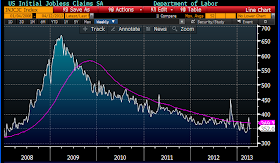The U.S. economy grew at a somewhat disappointing 2.5% annualized rate in the first quarter. However, if we exclude the first quarter decline in government spending (mostly related to cuts in defense spending), the increase was a more respectable 4%. This is an under-appreciated story: the private sector is doing reasonably well (much better than the GDP number suggests), even though the public sector is shrinking. In fact, it's probably more accurate to say that the private sector is doing OK because the public sector is shrinking.
The advance estimate of GDP growth for the first quarter was less than the economy's long-term average growth rate of about 3%. As the chart above shows, the economy is thus slipping further and further below its trend. This continues to be by far the weakest recovery in modern history.
As this next chart above shows, federal government spending has been flat for the past several years, and it has declined in the past several months, mainly due to declining defense spending. This has contributed to reported GDP growth coming in below expectations, but is that really a bad thing?
The first of the two charts above shows how much federal spending relative to GDP has declined in the past 3-4 years. The second chart shows the dramatic reduction in the federal deficit that has resulted from flat to lower spending and increasing tax revenues: the federal deficit has collapsed, from a high of 10.5% of GDP to only 5.75% today. These are arguably the biggest under-appreciated economic facts of recent years. Since federal spending is not growing, the federal government is shrinking relative to the economy at a fairly rapid pace. Since the economy is growing, especially the private sector, tax revenues are rising much faster than overall economic growth. Combined, these two developments have resulted in a major decline in the burden of the federal deficit.
Four years ago, no one forecast that this would happen, much less to this extent. What we see here is not only unprecedented but totally unexpected, and that is a big—and very positive—change on the margin.
There are more lessons here. The huge increase in spending that began in late 2008 and continued through 2009 utterly failed to stimulate economic growth. As I've pointed out before, that's because the stimulus spending was all about income redistribution:
Fully 63% of the "stimulus" spending was income redistribution in disguise (i.e., tax benefits and entitlements). And if you reclassify things such as education, housing assistance, and health as transfer payments, then over 75% of the $840 billion allocated to "stimulus" was essentially income redistribution. Only 8%—$65.5 billion—went for transportation and infrastructure (i.e., the "shovel-ready" projects that would put American back to work). Not a dime went to increase anyone's incentive to work harder or invest more.
Since spending all that extra money failed to stimulate growth, it should not be surprising that the reduction in government spending relative to the size of the economy in the past few years has failed to materially weaken growth. We've been on a growth path of roughly 2% per year for the past several years, despite the big swings in spending relative to GDP:
Why the slow growth? I think the recovery has been very sub-par for a variety of reasons. For one, government transfer payments and government spending in general do little if anything to grow the economy. The government is an inefficient allocator of economic resources, and big spending inevitably entails crony capitalism (e.g., Solyndra), corruption, and waste. Transfer payments create perverse incentives, rewarding those who don't work and penalizing those who do. In other words, one reason the economy has been expanding slowly is because we've been wasting scarce resources in a big way, starting with the big "stimulus" spending of 2009. Two, the expansion of the size and scope of government has also entailed huge new regulatory burdens (e.g., Frank-Dodd), and the looming introduction of Obamacare has created great uncertainty among many small businesses since it threatens to significantly increase their costs. For example, small businesses with fewer than 50 employees face huge marginal cost increases if they expand, since they would be forced to either pay a stiff penalty or provide costly insurance to their employees. With businesses unwilling to expand, millions of the unemployed have confronted the dearth of new jobs and decided to drop out of the labor force, hence the relatively high level of unemployment.
Unfortunately, even though the burden of government (i.e., spending relative to GDP) is declining—thus giving more breathing room to the more productive private sector—government-induced headwinds are scheduled to increase significantly next year if Obamacare is fully implemented, and that has already been holding the economy back. Also, it's likely that entitlement spending will increase in the next several years due to aging baby-boomers. So while the recent and ongoing decline in the burden of government spending augurs well for future economic growth, the gains are likely to be muted unless regulatory burdens are reduced and entitlement programs are reformed.
If there is a silver lining to this big-government cloud, it's the growing realization that Obamacare is not going to work as advertised. Max Baucus' decision to not run for re-election in Montana next year is likely due at least in part to his fear that Obamacare will be a train wreck. Since I don't see how Obamacare can work well, much less be implemented on time, I think there is a reasonable chance that before the end of this year Congress could decide to postpone its implementation for at least a year. That could be a very positive development.



















































